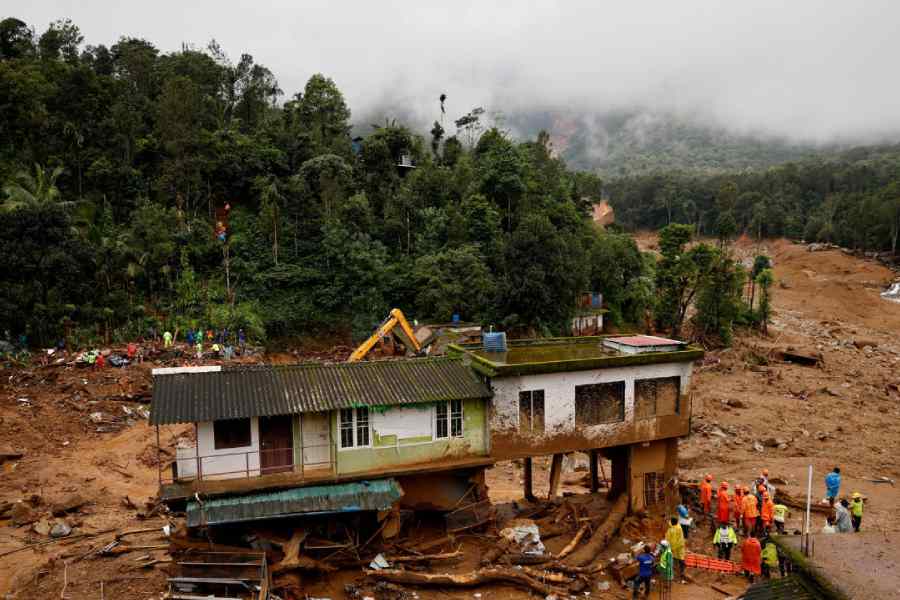The breathtakingly beautiful Wayanad, which recently suffered Kerala’s most fatal landslide that took over 400 lives (although the official toll is 231), was called a Vishakanyaka (The Toxic Nymph) who seduced and killed by the Jnanpith-winning Malayali author, S.K. Pottekkatt, in his eponymous novel of 1948. The work dwelt on the multitudes who migrated into the dense and mountainous Western Ghats region during the 1940s. Lured by Wayanad’s free and fertile soil, many of them perished fighting wild animals, diseases, hostile terrain and climate. To the early chroniclers, it was a human saga of audacity and agony, akin to the White Americans’ portrayed quest of the Wild West.
Subsequently, awareness of ecology, the rights of indigenous people and the emergence of ecocriticism transformed this perspective dramatically. The fortune-seeking mass migration into virgin lands, be it the Wild West or Wayanad, came to be seen as an assault on nature and indigenous people. In 2011, the Madhav Gadgil-led Western Ghats Ecology Expert Panel described how the verdant Wayanad has been ecologically ravaged by widespread construction, mining, quarrying and other human activities. However, the entire political class, the Church and the mining and construction lobbies collectively worked to debunk Gadgil’s findings.
Debate is still raging over whether natural or anthropogenic factors caused the catastrophe in the ‘green paradise’. The anti-Gadgil camp dismisses any role of human intervention as against the view of scientists and environmentalists. According to a post-disaster rapid study by the World Weather Attribution, an international consortium of scientists, although climate change-driven excessive rainfall triggered the landslide, factors like land use changes, unsustainable farming practices, deforestation, construction, quarrying and poor water drainage management have also contributed. A committee of scientists appointed by the state government also made similar findings. According to the Geological Survey of India, India is one of the countries worst affected by fatal landslides, and Kerala faced most of them (2,238 of the 3,656) during 2015-20. Human activities like construction triggered 28% of the Indian landslides. “It’s a man-made tragedy,” Gadgil said, accusing the state government of failing to implement his recommendations.
Another ongoing controversy is over whether advance alerts about intensive rains were issued by the Central agencies. While the Central government insists that the India Meteorological Department had issued alerts, the state government refutes this vehemently. Although this controversy remains unresolved, what is indisputable is that there have been enough warnings for some time about an approaching apocalypse.
The assault on Wayanad’s fragile environment has a long history. More parallels can be drawn between the American Wild West and Wayanad. The invasion of Wayanad’s landscape was initiated by the British colonialists in the mid-19th century like their influx to the Wild West. Much like the California Gold Rush, the first British incursion to Wayanad was also for mining gold. Scores of British and Australian companies were mining in Nilgiri-Wayanad by the 1880s. However, the yellow metal proved elusive in Wayanad. This led many mining companies to set up coffee and tea plantations in Wayanad’s pristine high ranges. Like the American westward expansion, this caused massive deforestation, genocide of wildlife and marginalisation of indigenous people. By 1860, as many as 80 British companies owned over 10,000 acres of coffee and tea plantations, clearing up densely forested hills and valleys. Slave labourers, drawn from the local tribes and also from neighbouring regions, toiled under inhuman conditions in these plantations. After Independence, most of these European-owned plantations came into Indian hands.
The second mass migration to Wayanad began during the 1940s from other regions of Kerala as well as Karnataka. They were encouraged to do farming by the governments and Christian churches to address food shortages of the post-War years. Mostly consisting of middle or lower-class Syrian Christians from central Kerala, they acquired lands by encroaching on forests or alienating tribal lands. “The hills of Wayanad have been a frontier region for loggers, elephant catchers, and gold diggers for centuries. After independence the region became a frontier for expanding agrarian capitalism. Its forested landscape became the site of a ‘land-rush’ of internal colonisation,” said a 2012 study by Daniel and Ursula Münster for Munich’s Rachel Carson Centre for Environment. They found that Wayanad’s agriculture was transformed after the 1970s into a market-oriented speculative enterprise and a hub for intensified and chemicalised farming of cash crops such as pepper, ginger and rubber, with high initial yields. They mentioned Wayanad’s farmers arriving in town to sell jeep-loads of pepper and returning with jeeps loaded with cash and chemical fertilisers. Another recent international study said that Wayanad lost 62% of its forest cover while the area under plantation grew by 1800% after Independence.
The end of the 1990s marked the end of El Dorado with the crash of global prices for hill produce and the steep decline in productivity. The Münsters said that this led to further intensification through more “chemicalisation” and conversion of paddy fields. The results were further toxification and desiccation of soil and escalation of indebtedness that ruined small farmers. Wayanad witnessed over 100 farmer suicides in the last 15 years.
When farming hit its limits, farmers shifted to a post-agrarian economy that included tourism. The Münsters called it the neoliberalisation and commodification of nature. Wayanad was the jewel in the crown of God’s Own Country, which became a global tourism destination. However, as happened in farming, a feverish expansion of tourism broke the fragile landscape’s sustainability thresholds, debunking claims about “responsible or ecotourism”. Today, hundreds of authorised and unauthorised tourist infrastructures dot Wayanad’s fragile ecology, which also triggered widespread quarrying. Even the region that witnessed the latest disaster, marked ecologically most sensitive, has posh resorts and quarries in its neighbourhood. A recent research article on Wayanad said that despite the prevalent and persuasive arguments favouring tourism, it has led to erosion of agrobiodiversity, displacement of local communities and increased human-animal conflicts.”
In 2019, a devastating landslide rocked Puthumala, three kilometres away from Mundakkai, which has been ravaged now, killing 17 people. In 2018, which saw record rainfall, Wayanad district witnessed 72 landslides and 625 landslips. As many as 69 people have been killed and over 1,000 injured in human-animal conflicts in Wayanad since 2011. The state government figures show that of the 4975.52 hectares of forest lands encroached in Kerala, 949 hectares were in Wayanad. The Kerala Biodiversity Board says the Wayanad agro-ecosystem has lost 160 varieties of rice, 12 varieties of pepper, 13 types of bananas and numerous vegetables and tubers. The state’s ‘responsible tourism’ documents admit that mass migrations to Wayanad have negatively impacted the tribal community causing large-scale land alienation, deprivation and a dwindling population. The WWA study points to a likely increase in landslides in future and recommends better protection of forests and regulation of activities such as construction and quarrying.
Kerala has always shown exemplary collective spirit in organising rescue and relief operations after disasters. Yet, when coming to prevention, it almost collectively looks away. Even after the catastrophe, local populations are reluctant to move out of dangerous zones. Fearing popular backlash, political parties and religious leaders resist regulations on human activities. The state government plans to have an eight-kilometre-long, Rs 2,000-crore twin tunnel road piercing through the unstable region devastated in the midnight of July 30. What is more disastrous, the landslide or the continued apathy?
M.G. Radhakrishnan, a journalist based in Thiruvananthapuram, has worked with various print and electronic media organisations










